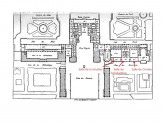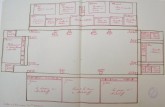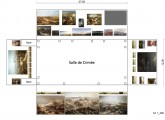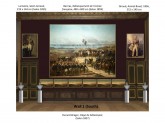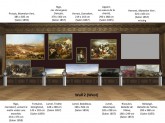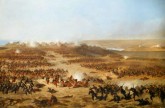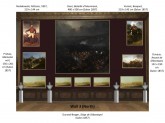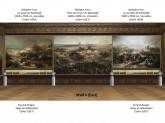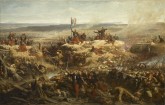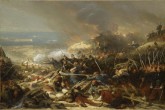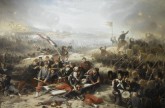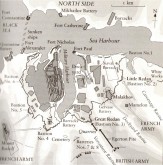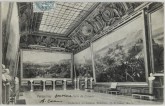The browser will either open the file, download it, or display a dialog.
Between 1855 and 1861, eighteen artists, some established, others emerging, worked on forty-four paintings for the Salle de Crimée, a new room at the Museum of French History in Versailles dedicated to celebrating and commemorating the recent Crimean War (1854–56) in paint (see Appendix A). With this project, the Second Empire (1852–70) arts administration hoped to win over public opinion, still fluctuating between resentment at the young empire’s failure to keep its initial peace promises, and acceptance of the partly successful outcome of the war, which had helped restore France’s glory.
Using a draft of an intended installation drawn by the museum’s curator, Eudore Soulié (1817–76), this article reconstructs one phase of the plans for this major nineteenth-century project. It suggests that the Salle de Crimée displayed paintings in a range of genres and styles and thus differed crucially from the artistically coherent projects realized in Versailles by the previous regime, the so-called July Monarchy (1830–48). By highlighting different aspects of the war, the paintings of the room managed to capture the geographical diffusion and temporal extension of this conflict, which is commonly regarded as a watershed in modern warfare due to the use of long-range weapons and mass mobilization. Never completed as planned, and disassembled by the beginning of the twentieth century, the Salle de Crimée has not been given the scholarly attention it deserves.[1] This article contends that, despite the room’s ephemeral nature, it was both politically and artistically important at the time, being one of the arts administration’s main focuses of the late 1850s and the impetus for the emergence of a new generation of military painters.
Much was at stake in this artistic project. Napoleon III’s young regime was based on popular support, but this had waned during the Crimean War, fought between the Russian Empire on one side and the alliance of the French Second Empire, the British and Ottoman Empires, and the Kingdom of Piedmont-Sardinia, on the other.[2] The war was the climax of a long struggle between the major European powers for influence over the territories of the declining Ottoman Empire and the Black Sea. Only after a twelve-month siege did the French troops and their British and Turkish allies manage to capture the Russian naval base at Sevastopol, which had become the focus of the conflict. However, whether the fall of Sevastopol in September 1855 and the planting of the French flag on the Malakoff, the Russian bastion protecting the city, was the victorious endpoint of the war was open to interpretation.[3] While the fighting was over, the war was not officially concluded until the end of March of the next year. The signing of the peace treaty in March 1856 brought an end to a conflict that had continued much longer than anticipated and had been marked throughout by logistical and tactical errors on the part of the allies.[4] These circumstances, as well as the high death toll and Napoleon III’s initial promises of peace when he had come to power only a few years previously, meant that the retrospective representation of the war took on a special political urgency, geared toward regaining the trust of a suspicious French public.[5]
The medium of painting became instrumental in (re)writing the history of the Crimean War. From 1857 to 1861, large-format paintings showing the conflict in a celebratory mode dominated the annual Salons, held in the Palais des Champs-Élysées, where most hung in the first room the visitors would enter.[6] Most military paintings were commissioned by the government for the purpose of being placed in the Museum of French History in Versailles.[7] While it is likely that Napoleon III himself had the idea for an entire room in Versailles dedicated to the Crimean War, Frédéric de Mercey, chef de la section des beaux-arts du Ministère d’État, seems to have been the first to articulate the plan on paper, shortly before or in 1856, the year in which the peace treaty was signed.[8] In a report addressed to Achille Fould, the minister of state who approved the commissions, de Mercey gave an overview of the commissions initiated thus far and outlined future plans. Military subjects commissioned and finished, de Mercey noted, comprised the Siege of Rome (1849), the Algerian conquest, and the Crimean War. While he considered the first two military subjects as sufficiently covered, de Mercey suggested that the commissioning process of Crimean War subjects was just starting, advocating that “a room of vast dimension . . . be dedicated solely to the Crimean War.”[9]
The Crimean room was to be integrated into the Museum of French History in Versailles, founded by King Louis-Philippe (1773–1850) in 1837.[10] The Crimean paintings would continue the project of illustrating national history begun by Louis-Philippe, who had commissioned three large rooms that formed an enfilade in the north wing of Versailles and commemorated the events of the African campaign fought during his reign. Over the course of ten years, beginning in 1838, the eminent battle painter Horace Vernet (1789–1863) had illustrated the military campaign on large paintings and had directed the complementary décor for the Salle de Constantine, the Salle de la Smalah, and the Salle de Maroc.[11] This major July Monarchy project was the prototype that de Mercey must have had in mind when he suggested the creation of a room dedicated to the Crimean War.
From the outset, however, the two regimes’ projects differed. One of Louis-Philippe’s impetuses for the commemoration had been the fact that his sons had participated in the African Campaign, while Napoleon III and his family had largely stayed out of any military action;[12] hence, they were not to be depicted in the paintings, allowing for a greater emphasis on the generals and common soldiers. Furthermore, whereas Louis-Philippe had planned the three rooms in close collaboration with his favorite artist, Vernet, Napoleon III was not as directly involved in the project in Versailles. The Salle de Crimée would instead be a team effort by several artists, commissioned by different government officials.
In his 1856 report, de Mercey proposed that the room contain four “grand compositions” representing four major events of the Crimean War: the landing of the troops; two battles (Alma and Inkerman); and the attack on the last Russian stronghold, the Malakoff tower, and Sevastopol’s capture (he counted the latter two subjects as one composition).[13] These four subjects should each occupy one wall of the room and be connected by ten representations of “secondary events,” which he also listed. As if this were not enough, he advocated the commissioning of two more paintings of other events related to the Crimean War, to be hung in an annex attached to the main Crimean room. A painting of the return of the French troops to Paris should, de Mercey proclaimed, “complete the series of these glorious events.” The report finished with a list of the Crimean subjects and a rough calculation of costs (annotations of the names of artists to be commissioned were probably added later, as they are in a different handwriting and in pencil). De Mercey estimated 20,000 francs for each painting of “primary rank” and 6,000 francs to 10,000 francs for the paintings of “secondary rank.”[14] As we shall see in the following, the “annex” was never realized, and even de Mercey’s plans for the main Salle de Crimée were frustrated during the subsequent commissioning process.
Over the following years, Eudore Soulié, the curator in Versailles, was the project coordinator for the venture. On November 19, 1856, he wrote to the general director of the Imperial Museums, Alfred-Émilien Comte de Nieuwerkerke, that Napoleon III and the minister of state, Achille Fould, had approved of the idea of a room dedicated to the Crimean War, for which was envisaged the former Salle de Maroc, left unfinished at Louis-Philippe’s abdication in 1848.[15] According to Soulié, the emperor had also accepted the basic arrangement (“les principales dispositions”) of the paintings. For decisions on the exact placement of the already existing paintings and on which subjects were still to be commissioned, Soulié was expecting a visit by de Mercey, who, as the above-mentioned 1856 report suggests, seems to have been the originator of the project. In the same letter, Soulié invited Nieuwerkerke to attend this meeting, giving us an insight into the great number of parties involved in the creation of the Salle de Crimée. These included the emperor, the Ministère d’État represented by Achille Fould, the Direction des Beaux-arts under the aegis of de Mercey, Nieuwerkerke as director of the Imperial Museums and finally Soulié, who was on site as the curator in Versailles. As was typical for official commissions under the Second Empire,[16] the costs for the paintings were split between the two official organs responsible for art commissions: the Direction des Beaux-arts and the Civil List (the funds accorded to the sovereign by the government).[17]
Among the paintings already existing in 1856 were three that had been exhibited at the Salon of 1855: a depiction of the Battle of Alma by Joseph-Louis-Hippolyte Bellangé (1800–66), a portrait of the late commander-in-chief Marshal Leroy de Saint-Arnaud (1798–1854) by Charles-Philippe Larivière (1798–1876) and a painting entitled Sœurs de la charité (Sisters of Charity), showing nurses helping the wounded soldiers in the Crimea by Eugène Appert (1814–67).[18] However, the bulk of the paintings destined for the Salle de Crimée were either not commissioned yet or at this point still under way, with thirty-three to be exhibited at the Salon of 1857.[19] Among these were portraits of the leading generals in the Crimea by well-known artists such as Horace Vernet as well as paintings by artists who were also military officers and worked for the Dépôt de la Guerre, such as Antoine-Valentin Jumel de Noireterre (1824–1902) and Jean-Baptiste-Henri Durand-Brager (1814–79).[20] Durand-Brager—a captain who had exhibited paintings of naval battles at the Salons and acted as a pictorial war journalist for L’Illustration during the Crimean War—was now paid by the Civil List to produce a major cycle of twenty-one paintings showing the Crimean terrain and everyday skirmishes of the siege of Sevastopol.[21]
The three most prestigious commissions—among the four subjects specified by de Mercey in his report: the battles of Alma and Inkerman and the capture of the Malakoff—were funded by the Direction des Beaux-arts and given to artists who did not have military careers and had focused on history painting before.[22] Gustave Doré (1832–83) was asked to paint the Battle of Inkerman, a commission that he hoped would mark “a serious beginning” of his “career as an artist.”[23] His painting, although not finished yet, was exhibited at the Salon of 1857 to great critical acclaim.[24] Adolphe Yvon (1817–93) and Isidore Pils (1815–75) were charged with the room’s other main works, the representations of the capture of the Malakoff and the Battle of Alma. All three artists had only recently turned their attention to military subjects, probably lured by well-paid official commissions and prestigious decorations as well as the prospect of being immortalized in—as it was now called—the Musée Impérial de Versailles.
Once the war was over, the arts administration sent Yvon to the Crimea to make sketches of the battle sites to prepare what was intended to be, at 6 by 9 meters, the centerpiece of the Salle de Crimée: the depiction of the taking of the Malakoff.[25] The subject was an important part of post-war politics, as the somewhat unsatisfactory ending to the Crimean War could only be interpreted as a French (rather than as an allied) victory if the French troops’ capture of the Malakoff tower, the last Russian stronghold, was defined as the endpoint of the conflict. On de Mercey’s suggestion, Fould agreed to increase the originally stipulated payment of 20,000 francs to 25,000—due to, as de Mercey explained, “the importance of the work”—making it the most expensive painting of the Salle Crimée.[26] It was first exhibited at the Salon of 1857, the venue where most of the major commissioned military paintings destined for the Salle de Crimée were first presented to the public. The sheer number of paintings of the Crimean War—there were over one hundred, if all media and all military genre scenes are included—resulted in an overt celebration of military strength at the Salon of 1857.
Only after the overwhelming success of Yvon’s painting at the 1857 Salon, in January 1858, did the Direction des Beaux-arts officially charge the artist with two further paintings, for another 20,000 francs each, of the events surrounding the capture of the Malakoff.[27] Together, the three paintings would form a coherent trio in the Salle de Crimée. This piecemeal commissioning process might be explained by the fact that Yvon had never painted a contemporary history subject before his first Malakoff painting and was, politically speaking, an unknown quantity.
Similarly, Pils was charged with the depiction of the Battle of Alma after his success at the Salon of 1857 where he had exhibited a painting of the landing of the French troops in the Crimea, executed for the Emperor’s cousin, Prince Napoleon.[28] For the Bataille de l’Alma (Battle of Alma), measuring 5 by 9 meters, the government agreed to pay the artist 20,000 francs. The battle was among the military subjects most frequently exhibited at the Salons over the course of the Second Empire.[29] Of the planned French attacks during the Crimean War, the battle, fought on September 20, 1854, was one of the few to have had a successful outcome and the government consequently held it up as an example of the skill of the French High Command in face of its often-questioned capability. Although he probably never went to the Crimea, Pils worked on this prestigious commission over the course of four years, only exhibiting his Bataille de l’Alma at the Salon of 1861.[30]
Whereas the large Crimean War paintings were shown at the Salons primarily to draw attention to the recently concluded war and influence its public perception, in Versailles they would fulfill a different role. According to de Mercey’s plan of highlighting different aspects of the war, from the start of the project the paintings were meant to form a fragment of a narrative. Critics, aware of the government’s plans for a room in Versailles, often judged the paintings as part of a cycle.[31]
The paintings commissioned to commemorate the Crimean War did not, however, closely follow the concept conceived by de Mercey—several subjects suggested in his 1856 report were never painted[32]—and varied from his recommendations in regard to size, style, and placement. Although de Mercey had mentioned, as early as 1856, the concept of one main room being dedicated to the Crimean War, the correspondence that followed between Nieuwerkerke and Soulié suggests that de Mercey’s lofty vision posed numerous practical problems on site. It was not clear, for example, where the Crimean paintings would finally hang and whether it would even be possible to install them all in the same room.[33] The portraits of the Crimean generals were at this early stage seen as an entirely separate project, simply continuing a series of portraits of former generals who had served under the previous regime.[34] The eventual decision on the location seems to have been made after Yvon visited Versailles in autumn 1857. The artist was probably consulted on the placement as he had, with his trio showing the taking of the Malakoff, provided the most prestigious representations of the war.[35] He argued in a letter to de Mercey in 1857 that the trio’s height of 6 meters precluded its placement in any room other than what was at this point still called the Salle de Maroc.[36]
In autumn 1859, Nieuwerkerke and Soulié decided that sufficient paintings had been accumulated to begin the installation, and the room they chose for the display was indeed the Salle de Maroc, which Yvon had suggested two years previously (fig. 1).[37] Its ceiling decorations, which displayed the scenes of the 1844 campaign of Morocco, still bore witness to the July Monarchy’s aborted project.[38] Louis-Philippe’s original plan had been to imitate the visual strategies of the then-popular panoramas in order to inspire in the spectator the sense of being at the site of the battle.[39] To accomplish this effect, a painting was supposed to cover one entire wall, and painted columns in the foreground of the painting were meant to blend with the columns of a real balcony railing to create a gradual transition from the painting to the actual room.[40] In contrast, the Salle de Crimée would return to a more conventional concept, with paintings hanging next to and above each other as at the annual Salon.
One idea for the installation of the Salle de Crimée can be reconstructed from a plan (figs. 2, 3) that Soulié enclosed with a letter to Nieuwerkerke in 1859.[41] The curator drew the room in top view and indicated the paintings as small boxes drawn in relative size to each other, labeling them with the artists’ names and the paintings’ titles. Small squares in front of the paintings stood for marble busts of generals who had fought in the Crimean War and whose names Soulié also indicated in his plan. We can assume that this plan had largely been put into practice by 1860, as the museum guide of that year lists all the paintings and busts indicated in the plan as installed in the Salle de Crimée, which was, the guide explains, meant to “commemorate the principal facts and figures of the Crimean expedition.” The guide furthermore describes the events shown in the paintings (mostly using extracts from the Salon catalogues) and lists the biographies of most of the generals represented in the portraits and the marble busts.[42] However, the guide also notes that “[the room’s] installation is not completely finished,”[43] probably because Pils’s large painting of the Battle of Alma was not completed yet and would replace several other paintings that hung in the room in 1860. In the following, I will nevertheless reconstruct the installation as suggested by Soulié in 1859, as it probably came closest to a Salle de Crimée as envisaged at the outset of the project.
Soulié’s plan roughly followed de Mercey’s original concept of the Salle de Crimée: each of the room’s walls illustrated milestones of the Crimean War in a more or less chronological, clockwise arrangement. The narrative began on the short wall between the two doors (fig. 4), with a view of the landing of the French troops on the Crimean peninsula, painted by Félix-Joseph Barrias (1822–1907). This represented the first step by the French in a foreign land far away from home. It was framed to the left by a portrait of the first commander-in-chief of the French troops in the Crimea, Marshal Saint-Arnaud, and to the right by a portrait of the commander of the French fleet in the Black Sea, Admiral Armand Joseph Bruat (1796–1855). Both men had died during the Crimean War. Underneath Barrias’s painting, six small works by Durand-Brager showed the barren Crimean terrain surrounding Sevastopol. These small-format paintings were part of the earlier-mentioned series of twenty-one works entitled Siège de Sébastopol (Siege of Sevastopol) that illustrated military action in the Crimean terrain, and continued on two other walls of the room:[44] probably commissioned specifically for this room, their sizes matched the room’s proportions.[45] All of Durand-Brager’s paintings were installed at the lowest level, forming a continuous strip.
According to Soulié’s 1859 plan, the room’s narrative continued on the long west wall with paintings of the events leading up to and during the siege of Sevastopol (fig. 5). Pils’s Bataille de l’Alma was probably intended to hang here eventually as this was the only wall, apart from the facing wall always meant to be occupied by Yvon’s trio, that could comfortably accommodate the large canvas. However, in the provisional plan of 1859, twelve paintings addressed subjects such as suffering, death, and the battles fought during the siege, which had been favorably reported by the censored press as French victories.[46] Marshal François Certain Canrobert (1809–95), the commander-in-chief who had led the battles during the siege after Saint-Arnaud’s death, was prominently displayed in the center of the wall in a portrait by Vernet. On either side of this portrait, paintings by Jules-Alfred-Vincent Rigo (1810–92) and Appert introduced the doctors and nurses helping the wounded soldiers as key figures in the siege; meanwhile, in the lower left, another painting by Rigo showed Canrobert visiting his injured soldiers.
The rest of this wall displayed battles that had interrupted the long wait in the trenches. The large canvas by Antoine-Valentin Jumel de Noireterre (1824–1902) in the center of the lower tier of the wall, which would have been replaced by Pils’s canvas if the Salle de Crimée had been completed, illustrated the Battle of Balaklava when the French had rescued their British allies from a Russian attack (fig. 6). As a Dépôt de la Guerre employee, Jumel de Noireterre was interested in documenting the exact positions of the battalions as well as the layout of the battlefield, and presented the conflict from a bird’s-eye perspective.
The brutality of the bloody battles fought during the siege, which had prompted criticism of the war among the French public, could be found only in one painting, by Alexandre Protais (1826–90), in the upper left corner of the long west wall (fig. 7).[47] It shows the French taking of the Russian defense structure, Mamelon Vert. Although the French lost almost 7,500 men during the assault, it was the only success after months of failed operations.[48] On the right of the painting, a group of running French soldiers is placed close to the picture plane. Some of them are depicted sinking to the ground as they are hit by the incessant hail of Russian artillery fire. On this wall, Protais’s painting remained the only one to directly address the subject of killing of French soldiers, functioning as a memorial of the soldiers’ sacrifice in the Crimea. As the critic A.-J. Du Pays noted when the painting was shown at the Salon of 1859, it also stands out as it employs a different visual language, which he perceived as non-artistic or “extra-pittoresque.”[49] Protais depicted most soldiers from the back, which, the critic found, emphasized the painting’s historical truthfulness.[50] That critics were aware that the artist had witnessed the attack on the Mamelon Vert might explain why they did not dispute the historical accuracy of the painting, which was designated in the Salon catalogue as “after a drawing executed by the author, during the operation.”[51] Du Pays’s comment that the painting’s documentary qualities made it suitable for the display in Versailles confirms that historical documentation was indeed the primary function of the Crimean War paintings.[52]
Turning to the short wall to his right and opposite the entrance, the visitor would have seen Doré’s arresting painting, in a large square format, of the clash of nations (fig. 8). This image of the Battle of Inkerman, when the French again came to the aid of their British allies, is executed with such painterly expression and strong colors that it would have stood out from the display of the room, suggesting the notion of the heroic struggle in one powerful image. To the left of Doré’s painting, a portrait by the Polish artist Henryk Rodakowski (1823–94) showed General Aimable-Jean-Jacques Pélissier (1794–1864),[53] who succeeded Canrobert as commander-in-chief and who finally led the French and British to victory against the Russians; he was still alive when the Salle de Crimée was installed in 1860.[54] On the other side of Doré’s square canvas hung a painting by Vernet of General Pierre Bosquet (1810–61), who had become a celebrated hero by 1860 for his brave leadership of his famous Zouave regiment.
Finally, turning to the last wall (fig. 9), the visitor would have taken in the centerpiece of the room: Adolphe Yvon’s three paintings illustrating what the French government retrospectively defined as the endpoint of the war. The subject of the central painting, entitled Prise de la tour de Malakoff, 8 septembre 1855 (Taking of the Malakoff, September 8, 1855; fig. 10), is the very moment when the French penetrated the Russians’ defense structure that protected Sevastopol, the “Malakoff,” while La gorge de Malakoff (The gorge of the Malakoff; fig. 11) and La courtine de Malakoff (The courtine of the Malakoff; fig. 12) show, from different angles, actions before the taking of the defense structure.[55]
Prise had already stood out at the Salon of 1857 due to its sheer size (6 by 9 meters) and, with its non-hierarchical composition, struck visitors to the Salon as a new way of depicting war.[56] It shows only a few Russians, recognizable by their brown uniforms, while the colorful French uniforms of the Zouave regiment dominate the rest of the canvas. Most of the Zouaves are portraits, which were identified in a key installed underneath the painting at the Salon and in Versailles, as one can discern in a photograph[57] of the painting at the Salon and in a postcard of the Salle de Crimée discussed later. As Stefan Germer has demonstrated in his 1997 essay on the influence of new viewing habits on the production and reception of history painting, Prise is made up of simultaneous actions rather than a conventional chronological narrative, an effect that changed the act of viewing.[58] This simultaneity, Germer argues, resulted in a distracting viewing experience that was geared toward mass reception.[59] It helped to diffuse political weak points, such as the fact that the depicted assault was the second major attempt by the allies to capture the bastion. Contemporaries found it hard to determine the content focus of the composition. The critic A.-J. Du Pays considered it to be the young corporal of the Zouave regiment[60]—mentioned in the Salon catalogue of 1857 by his name, Lihaut[61]—holding the French flag, whereas Jules Verne asserted that the figure of General Patrice de Mac Mahon (1808–93) dominated the composition.[62] Conservative art critics thought that Yvon’s placement of a corporal on the same level as the celebrated general was trivializing the High Command.[63] Du Pays, on the other hand, praised this aspect of the painting for showing that the capture of the Malakoff was a “victory of soldiers.”[64]
Yvon further reversed the hierarchy by relegating the most eminent French figure of the last months of the war, Pélissier, to the background, where his presence is barely noticeable but for a tiny French flag. When Pélissier confronted Yvon about this, the artist upheld the historical truth, arguing that the marshal had not been in the field during the capture but had instead watched the assault from where the artist had placed him in the painting.[65] Considering that Yvon could have depicted the scene from a different viewpoint (he chose to show the capture from the enemy’s viewpoint) and had taken artistic liberties ignoring certain military details, it seems doubtful that historical truthfulness was really the only underlying rationale for his pictorial solutions.[66] Not only did the ultimate commissioner of the painting, the emperor, have a difficult relationship to Pélissier, but the allied High Command also held Pélissier responsible for the humiliating defeat at the first attempt to capture the Malakoff several months before the assault depicted in Yvon’s canvas.[67] This first planned assault on the Malakoff on June 18 had ended in carnage, causing a trauma that would stay irrevocably in the French public consciousness. The French lost 6,000 men, partly because Pélissier had adopted sudden last-minute changes of plan, which unsettled the French troops and disjointed their plan of action from that of the British troops. Whereas Yvon might have thus acknowledged Pélissier’s difficult standing, a marble bust that Soulié’s plan envisaged to stand to the left of the visitor contemplating the painting nevertheless immortalized the general.[68] To the visitor’s right, a marble bust of General Bosquet stood close to one of the most controversial parts of Yvon’s canvas:[69] the Russian—shot in the back of the head by a French rifleman—who is falling toward the viewer. Contemporaries at the Salon had experienced a sense of confusion as they were not sure from which spot they were meant to view the painting and felt that the tumbling Russian was extending into the viewer’s space.[70]
In Versailles, however, the confrontational pictorial rhetoric of Prise was to some extent stabilized by the two flanking paintings, La gorge de Malakoff and La courtine de Malakoff. They display focused compositions and clear-cut moments instead of multiple incidents like Prise; furthermore, they show high-ranking generals prominently in the foreground, adding to the impression that they follow a more conventional pictorial rhetoric than Prise. Both illustrate ambiguous moments in the assault. La gorge de Malakoff shows the precarious moment when the French penetrated the inside of the Malakoff after the successful repulse of the Russian guards by Mac Mahon’s division depicted in Yvon’s central painting, while La courtine illustrates a moment in the assault when the French had already taken the Malakoff tower but were repulsed a second time from the Russian defense structure called “Little Redan,” indicated in the background at the right of the painting by an opaque cloud of white smoke.[71] In the far background of La courtine one can just discern the characteristically white architecture of Sevastopol while in La gorge, the visitor would have seen the only prominent representation of the city in the Salle de Crimée. Sevastopol was rarely depicted as the allies never actually captured the city but instead carefully entered it after the Russians had already departed.[72] Soulié envisaged in his 1859 plan (fig. 2) that La gorge should hang to the left and La courtine to the right of Prise, an arrangement that would have made sense geographically as the Little Redan displayed in La courtine was in reality located east of the Malakoff, as a map of the site demonstrates (fig. 13). However, the postcard of the Salle de Crimée (fig. 14) suggests that this arrangement was eventually reversed and that La courtine hung to the left of Prise, at least toward the end of the nineteenth century.
Yvon’s three canvases could be said to function like an “inverted” panorama, as they show the Malakoff from different angles.[73] Whereas in a panorama, a viewer would see the battle from a single viewpoint, here the battle is seen from different angles. The left-hand painting, La gorge, shows the struggle from southwest of the Malakoff; the central painting from the viewpoint of the enemy stationed in Sevastopol, looking toward the French troops’ location in the south; and the right-hand painting, La courtine, shows the struggle at the Malakoff from a viewpoint from where the High Command stationed southeast of Sevastopol would have seen it, with the Malakoff tower displayed at the far left. Furthermore, the right margin of the latter painting, La courtine, is rendered darker and blurred, emulating peripheral vision. That the Malakoff tower had to be defended against the enemy stationed at the defensive structures to the left and right also explains the diverging movement of the French troops toward the trio’s margins. The paintings were able to create a narrative tension only when seen together. Contemporaries greatly appreciated how they illustrated the French troops’ achievements in holding the French position on the Malakoff tower, despite “this movement by the enemy (which) could compromise or delay the victory.”[74] The three paintings were further tied together by the same height of the horizon line. Together, they formed an image of triumph, an impression that was enhanced by the soldiers in the central painting, proudly posing and facing the spectator.
In order to appreciate the overall effect of the room envisaged by the Second Empire arts administration, one needs to imagine it with Pils’s Bataille de l’Alma in place (fig. 15).[75] The wall opposite Yvon’s trio was the only place, apart from the east wall, that might have comfortably accommodated the large canvas and, at 5 by 9 meters, it would have created a visual counterweight to that trio. At the Salon of 1861, Bataille de l’Alma caused a sensation, several critics hailing the liveliness of its figures and its truthfulness in focusing on the common soldiers.[76] In contrast to the depictions of the same battle shown at earlier Salons by eminent artists such as Horace Vernet, which had focused on the High Command, Pils concentrated on General Bosquet and his Zouave regiment, who had in fact decided the victory of the day.[77] By the time Pils had completed this painting, General Bosquet’s order at the Battle of the Alma to attack the enemy from the flank instead of frontally as previously stipulated in the plan of battle, had become famous as the turning movement of General Bosquet.[78] Pils illustrated precisely this moment, when Bosquet’s regiment has arrived at the bottom of the Alma heights and starts to turn left to climb the hills from the side from where they will overpower the surprised Russians. The effort of scaling the heights destroys any military formation: in the midst of his regiment on the left, Bosquet is wading through the water on horseback. As the struggling figures are gathered at the lower margin of the canvas and are almost life-size, they seem more accessible than Yvon’s triumphantly posing soldiers.
With its forty-four paintings in different formats, genres, styles, and subjects, as well as marble busts, the Salle de Crimée did not function as an artistic whole. Rather, it selectively referenced the concepts and innovations of the nearby July Monarchy rooms, which appeared as carefully orchestrated ensembles by comparison. As Michael Marrinan has demonstrated in his important essay on their visual strategies and generated historical meanings, the Algerian paintings were innovative in the context of a history museum. The Salle de Constantine “retold” the history of the siege and capture of Constantine in several paintings that depicted fragments of the events.[79] Rather than suggesting to the visitor that he or she was witnessing the operations, the room’s decorative program, which connected the paintings that were painted in a similar style and by only one artist, Vernet, invited the visitor to connect the events into a story. Labels on the frames and in the decor as well as the guide’s long descriptions of the events displayed in the paintings supported this “reading” approach. Similarly, some of the Salle de Crimée’s paintings sought to describe the course of the Crimean War, rather than simulate its actions. As suggested by de Mercey, paintings of, as he labeled them, “secondary rank” connected representations of events and portraits of “primary rank” to form a narrative. As with the Salle de Constantine, the paintings of the Salle de Crimée did not speak for themselves but relied on textual support, such as plates identifying the figures depicted and lengthy descriptions of the historical events in the museum guide, in order for the room to give a (seemingly) complete picture of the war.
A direct reference to the July Monarchy project can be found in Yvon’s trio. As Katie Hornstein has pointed out, by showing an event on three formally related canvases, the trio directly draws on Vernet’s three paintings in the adjacent Salle de Constantine, which each depict a moment leading to the capture of Constantine of November 13, 1837 (Salon of 1839).[80] The underlying propaganda aims of the commissioning governments of Vernet’s and Yvon’s trios were also similar. The siege of Constantine depicted in Vernet’s trio was successful only at the second attempt,[81] as was the capture of the Malakoff. In both trios, the animated combats to the left and right are stabilized by the central canvas showing a final assault or victory. They differ in that the chronological sequence of Yvon’s canvases is more tightened as the moments depicted in each one are only separated by a few hours whereas the events shown in Vernet’s trio are separated by several days.[82] Furthermore, the central canvas of Vernet’s trio shows the final assault as the last stage of the siege whereas Yvon’s central painting illustrates what the French government sought to present as the final victory over the Russians: the actual capture of the Malakoff. Perhaps the governments of Louis-Philippe and Napoleon III both chose the format of a trio for the depiction of these ambivalent victories because the flanking canvases seem to attain historical accuracy by illustrating the struggles involved in gaining the victory.
Prise stands out from the narrative approach in that it is geared toward a more engaged spectatorship, suggesting to the visitor that he or she be part of the depicted battle. Here, Yvon referenced Vernet’s Prise de la Smalah d'Abd-el-Kader par le duc d'Aumale à Taguin, le 16 mai 1843 (The Taking of the Smalah of Abd-el-Kader by the Duc d’Aumale in Taguin) (Salon of 1845 and Salon of 1855), which shows the capture of the itinerant Algerian town made up of tents (called Smalah in Arabic), and which was hung in the nearby Salle de la Smalah in Versailles. As Marrinan argues, Vernet’s Smalah presents history as entertainment, an observation that can be transferred to Yvon’s depiction of the taking of the Malakoff.[83] In both Vernet’s[84] and Yvon’s canvases, elements seem to be moving toward the spectator; just as in Smalah, in which horsemen are depicted as charging toward the spectator, so in Yvon’s painting the Russian seems to be falling toward the viewer. In fact, the Salle de Crimée in general fostered an engaged spectatorship: the busts of generals were in the viewer’s space and Durand-Brager’s twenty-one paintings of the battlefield surrounded the visitor from three sides of the room.
Unfortunately, to my knowledge, there are no surviving contemporary accounts by visitors to the Salle de Crimée, which may have never existed as a room exclusively dedicated to the Crimean War. Only the above-mentioned postcard, which probably dates from the end of the nineteenth century, conveys a general impression of the room (fig. 14).[85] In it, Pils’s enormous Bataille de l’Alma is visible at the far end, relegated to the short north wall, where its rims almost touch the adjacent walls. At the left, on the wall facing the Malakoff trio, one can just discern, in extreme perspective distortion, the contours of the composition of Yvon’s Bataille de Solférino (Battle of Solferino) (Salon of 1861) with the vague silhouette of Napoleon III on horseback with his outstretched arm, which represented the Italian Campaign of 1859. Although the room was consequently not dedicated solely to the Crimean War any longer by the time the photo was taken, it nevertheless gives us an idea of how overwhelming the large formats of Yvon’s and Pils’s paintings must have seemed to a contemporary visitor. This effect was enhanced by the fact that the top of the canvases tilted forward, further dwarfing the viewer. The impression not only of the individual canvases but also of the ensemble of paintings in different formats, styles, genres, and subjects must have been one of visual overload, heightened by the marble busts placed at eye level in the space before the canvases. It becomes clear that the commissions for the Salle de Crimée were indeed designed more than anything else to impress and overwhelm the visitor, and thereby foreclose expressions of doubt about the conduct of the war.
The eclectic Salle de Crimée conveyed several messages, not pinpointing one official narrative in a climate when, despite the fiercely censored press, the long siege of Sevastopol had led a large part of the population to grow increasingly skeptical of the new government’s foreign policy.[86] Due to its size and arresting pictorial language, Yvon’s trio with its triumphantly posing soldiers would have immediately captured the attention of visitors entering the room (although, according to the chronology of depicted events, it was meant to be looked at last). It presented in a celebratory mode the ending of the Crimean War as a French victory and thus set the tone for the visit to the Salle de Crimée. If the room had been realized solely dedicated to the Crimean War, the visitor, looking at Yvon’s trio, would have literally turned his back on more critical reflections of the war. With both Protais’s commemoration of soldiers being hit by Russian artillery fire, and Pils’s painting, which shows soldiers struggling to cross a river, in place, this opposite wall would have been about the human cost of war.
The large-canvas formats, the entertaining visual language of Yvon’s central painting, and the emphasis on the deeds of the common soldier displayed in Doré’s, Yvon’s, and Pils’s renderings might have worked to distract the viewer from the High Command’s questionable conduct during the war. For the commemoration of the generals, the chosen media were portraits and marble busts, which, literally set in stone, represent the ultimate medium through which to ennoble individuals without having to show their supposed deeds. General Bosquet forms an exception, as he is prominently represented four times in the Salle de Crimée: severe and strong-minded in Vernet’s large, full-length portrait; immortalized and decorated in Nieuwerkerke’s white marble bust; stoically suffering in Yvon’s La courtine; and down-to-earth in close bond with his soldiers in Pils’s painting. The room thus catered to the etiquette of military honor, which was well suited to the translation into fine arts, while at the same time acknowledging that the French public had venerated Bosquet for his unpretentiously close bond with the common soldiers.[87] Finally, the monotony of the siege found expression in Durand-Brager’s paintings, which are visually similar to each other and restrict the depiction of the human side of war to showing tiny figures of soldiers and their relationship with the Crimean terrain.
The evasive character of the Salle de Crimée can be said to be a product of the Crimean conflict, which marked the beginning of modern warfare.[88] Long-range weapons, mass mobilization, and multiple theaters of war as well as the long duration of the siege at the gates of Sevastopol and its ending, which did not see a clear victor, meant that the war’s essence was impossible to summarize in one painting. One might argue that the room’s eclecticism—intentional or otherwise—managed to capture this new complexity of modern warfare.
In general, however, the Salle de Crimée fell short of de Mercey’s ambitious plans of 1856. Pils delivering his major canvas late, a drawn-out commissioning process, shortage of space, and too many protagonists must have led to the Salle de Crimée, intended for posterity, existing only briefly and partially. Today, four smaller rooms in the north wing are called Salles de Crimée et d’Italie, and here hang some of the Second Empire paintings, albeit covered for much of the time by temporary exhibition walls.[89] The Crimean paintings’ afterlife subsisted more in the form of prints and postcards than in their actual presence in Versailles.[90]
Looking back at Soulié’s achievements, Philippe de Chennevières, who worked for the arts administration under the July Monarchy and was in charge of the provincial museums and the organizing of the Salons under the Second Empire, wrote about the Versailles commissions in 1886:
The history museum, Louis-Philippe’s favorite and truly national work, was by that very origin brought into disrepute with the imperial regime, which did not pride itself on growing its collections, and was satisfied with continuing with its contemporary series by having its sergeants and main officers killed by the enemy in the war of Crimea and Italy painted or sculpted, and by dispatching to the remaining large rooms that were yet to be filled, the vast paintings by Horace Vernet, Pils and Yvon.[91]
There is an element of truth in Chennevières’s harsh critique, and the Salle de Crimée, devised by several protagonists and commissioned to numerous artists with varying professional backgrounds, was perhaps always bound to live in the shadow of the July Monarchy rooms. The Crimean paintings had enjoyed their heyday when they were shown at the Salons, where they influenced topical political sentiments and were discussed by critics in their own right, leading to the professional rise of their authors. Maxime Du Camp was proved correct when he wrote in 1861 that, after the Salons, the military paintings “would quietly find their place in the storerooms of Versailles, and no one would pay them any more attention.”[92]
Appendix A – Catalog of Paintings in the Reconstructed Elevations
[Return to the article by using the back arrow on your browser]
Wall 1 (see fig. 4):
Charles-Philippe Larivière, Portrait du maréchal Leroy de Saint-Arnaud (Portrait of Marshal Leroy de Saint-Arnaud), 1854. Oil on canvas. Châteaux de Versailles et de Trianon, Versailles.
Félix-Joseph Barrias, Débarquement de l'armée française à Old-Port, 14 septembre 1854 (Landing of the French army at Old Port, September 14, 1854), 1859. Oil on canvas. Châteaux de Versailles et de Trianon, Versailles.
Pierre-François-Eugène Giraud, Portrait d'Armand-Joseph, amiral Bruat (Portrait of Admiral Armand-Joseph Bruat), 1856. Oil on canvas. Châteaux de Versailles et de Trianon, Versailles.
Henri Durand-Brager, Panorama de Kamiesch (Panorama of Kamiesch), 1857. Oil on canvas. Châteaux de Versailles et de Trianon, Versailles.
Wall 2 (see fig. 5):
Alexandre Protais, Attaque et prise, le 7 juin 1855, du Mamelon-Vert et des Ouvrages-Blancs, par les troupes du 2e corps, sous le commandement du général Bosquet (Attack and capture of the Mamelon Vert and the White Works on June 7, 1855, by the troops of the 2nd corps, under the command of General Bosquet), 1859. Oil on canvas. Châteaux de Versailles et de Trianon, Versailles.
Jules-Alfred-Vincent Rigo, Les chirurgiens français pansant des blessés russes à la bataille d'Inkerman, 5 novembre 1854 (French surgeons bandaging wounded Russians at the Battle of Inkerman, November 5, 1854), 1857. Oil on canvas. Châteaux de Versailles et de Trianon, Versailles.
Horace Vernet, Portrait en pied de S. Exc. M. le maréchal Canrobert (Full-length portrait of His Excellency, Marshal Canrobert), 1857. Oil on canvas. Châteaux de Versailles et de Trianon, Versailles.
Eugène Appert, Les sœurs de la charité en Crimée (The sisters of charity in the Crimea), 1855. Oil on canvas. Châteaux de Versailles et de Trianon, Versailles.
François-Étienne Hersent, Siège de Sébastopol: le 3e régiment de zouaves et le 50e de ligne s’emparent du Mamelon-Vert, 7 juin 1855 (Siege of Sevastopol: the 3rd regiment of the Zouaves and the 50th of the line taking the Mamelon Vert, June 7, 1855), 1857. Oil on canvas. Châteaux de Versailles et de Trianon, Versailles. Listed in 1995 Versailles catalogue as missing, cat. no. 2633, MV 1966.
Jules-Alfred-Vincent Rigo, Le général en chef Canrobert, venant le matin visiter une tranchée attaquée pendant la nuit par les Russes, distribue aux blessés des encouragements et des récompenses (The Commander-in-Chief, Canrobert, while visiting in the morning a trench that was attacked by the Russians during the night, awards the wounded with promotions and rewards), 1859. Oil on canvas. Châteaux de Versailles et de Trianon, Versailles.
Edme-Adolphe Fontaine, Attaque de la redoute Selinghinsk (Attack of the Selinghinsk Entrenchment), 1857. Oil on canvas. Châteaux de Versailles et de Trianon, Versailles.
Antoine-Valentin Jumel de Noireterre, Bataille de Traktir (Battle of Traktir), 1857. Oil on canvas. Châteaux de Versailles et de Trianon, Versailles.
Antoine-Valentin Jumel de Noireterre, Bataille de Balaklava, 35 octobre 1854 (Battle of Balaklava, October 35, 1854), 1859. Oil on canvas. Châteaux de Versailles et de Trianon, Versailles.
Antoine-Valentin Jumel de Noireterre, Prise de Sébastopol, 8 septembre 1855 (Taking of Sevastopol, September 8, 1855), 1857. Oil on canvas. Châteaux de Versailles et de Trianon, Versailles.
Antoine Rivoulon, Bataille de l’Alma (Battle of Alma), 1857. Oil on canvas. Châteaux de Versailles et de Trianon, Versailles.
Joseph-Louis-Hippolyte Bellangé, Bataille de l'Alma, 20 septembre 1854 (Battle of Alma, September 20, 1854), 1855. Châteaux de Versailles et de Trianon, Versailles.
Wall 3 (see fig. 8):
Henryk Rodakowski, Aimable-Jean-Jacques Pélissier, duc de Malakoff (1794–1864), maréchal (Aimable-Jean-Jacques Pélissier, Duc de Malakoff (1794–1864), marshal), 1857. Oil on canvas. Châteaux de Versailles et de Trianon, Versailles.
Gustave Doré, La bataille d'Inkerman, 5 novembre 1854 (The Battle of Inkerman, November 5, 1854), 1857. Oil on canvas. Châteaux de Versailles et de Trianon, Versailles.
Horace Vernet, Portrait en pied de S. Exc. M. le maréchal Bosquet (Full-length portrait of His Excellency, Marshal Bosquet), 1857. Oil on canvas. Châteaux de Versailles et de Trianon, Versailles.
Alexandre Protais, Prise d’une des batteries du Mamelon vert; mort de M. de Brancion, colonel du 50e, 7 juin 1855 (Taking of an artillery battery of the Mamelon; death of M. de Brancion, colonel of the 50th, June 7, 1855), 1857. Oil on canvas. Châteaux de Versailles et de Trianon, Versailles.
Jules Duvaux, Siège de Sébastopol: le général Bosquet blessé lors de l’assaut de la courtine de Malakoff, 8 septembre 1855 (Siege of Sevastopol: General Bosquet wounded during the assault of the courtine of Malakoff, September 8, 1855), 1857. Oil on canvas. Châteaux de Versailles et de Trianon, Versailles.
Henri Durand-Brager, Bastion de la Quarantaine (Bastion of the Quarantine), 1857. Oil on canvas. Châteaux de Versailles et de Trianon, Versailles.
Wall 4 (see fig. 9):
Adolphe Yvon, La gorge de Malakoff, 8 septembre 1855 (The gorge of the Malakoff, September 8, 1855), 1859. Oil on canvas. Châteaux de Versailles et de Trianon, Versailles.
Adolphe Yvon, Prise de la tour de Malakoff, 8 septembre 1855 (Taking of the Malakoff, September 8, 1855), 1857. Oil on canvas. Châteaux de Versailles et de Trianon, Versailles.
Adolphe Yvon, La courtine de Malakoff, 8 septembre 1855 (The courtine of the Malakoff, September 8, 1855), 1859. Oil on canvas. Châteaux de Versailles et de Trianon, Versailles.
Henri Durand-Brager, Face droite du bastion du Mât (Right side of the bastion du Mât), 1857. Oil on canvas. Châteaux de Versailles et de Trianon, Versailles.
Henri Durand-Brager, Panorama des attaques de gauche, pris de l’Observatoire du maréchal Canrobert (Panorama of the attacks from the left, taken from the observation post of Marshal Canrobert), 1857. Oil on canvas. Châteaux de Versailles et de Trianon, Versailles.
An earlier version of this essay was given at the Association of Historians of Nineteenth-Century Art’s (AHNCA) annual session, “Future Directions in 19th-Century Art History,” at the 2013 College Art Association annual conference in New York. I would like to thank Martina Caruso, Orlando Figes, Anna Fukuda, John House, Frédéric Lacaille, Satish Padiyar, Susan Siegfried, Konrad Thoma, and Melanie Vandenbrouck.
All translations are by the author.
[1] The Salle de Crimée is mentioned in Annie Bardon, Militärmalerei im Second Empire am Beispiel des Krimkrieges (Marburg/Lahn: Philipps-Universität Marburg, 1980), 48; Albert Boime, Art in an Age of Civil Struggle, 1848–1871, vol. 4, A Social History of Modern Art (Chicago: University Press of Chicago, 2007), 601; and Catherine Granger, L'Empereur et les arts: La liste civile de Napoléon III (Paris: École des Chartes, 2005), 352. A detailed analysis can be found in the author’s PhD dissertation, Julia Thoma, “The Final Spectacle: Military Painting under the Second Empire, 1855–1867” (PhD diss., The Courtauld Institute of Art, 2013), 105–16.
[2] For a comprehensive historical account of the Crimean War, see Orlando Figes, Crimea: The Last Crusade (London: Penguin Books, 2010). On the public’s fluctuating opinions during the Crimean War, see Lynn Marshall Case, French Opinion on War and Diplomacy during the Second Empire (New York: Octagon Books, 1972), 15–50.
[3] Figes points out that the Emperor focused on Sevastopol as a symbol of victory to satisfy the French public and restore the image of his regime. Figes, Crimea, 328.
[4] The allied commanders expected a quick victory when the war started. See for example, Figes, Crimea, 280. Decisions such as not to attack Sevastopol quickly from the North but instead besieging it delayed the victory. The most famous misunderstanding among the High Command was the incident of The Charge of the Light Brigade at the Battle of Balaclava on October 25, 1854. See Figes, Crimea, 224, 246–53.
[5] Around 100,000 French men were killed in battle or lost through disease and illness. See Alain Gouttman, La guerre de Crimée 1853–1856: La première guerre moderne (Paris: SPM et Kronos, 1995; repr., Paris: Perrin, 2006), 393 (page references to the reprint edition) and Figes, Crimea, xix. With his famous words “The Empire means peace,” spoken at a visit to Bordeaux in 1852, Napoleon III sought to assure the French public and all of Europe of his peaceful intentions. See Discours, messages, et proclamations de S. M. Napoléon III empereur des français. 1849–1860 (Paris: Mirecourt, Humbert, 1860), 97–98.
[6] We know from contemporary photographs of the installations at the Salons and art critics’ reviews that officially commissioned paintings often came to hang in the Salon d’Honneur. The reviews of the 1861 Salon, especially, engage with this fact, as the large military paintings by Yvon and Pils in the first room must have seemed overwhelming. See, for example, Léon Laurent-Pichat, Notes sur le Salon de 1861 (Lyon: L’Imprimerie du Progrès, 1861), 2.
[7] Apart from Eugène Giraud’s portrait of Admiral Bruat and Rodakowski’s portrait of Pélissier, all paintings indicated in Soulié’s plan for the Salle de Crimée had been exhibited at the Salon. For the Salon dates, see the author’s annotations to the reconstructions of the room’s walls (figs. 4, 5, 8, and 9).
[8] I am indebted to Frédéric Lacaille, conservateur en chef en charge des peintures du XIXe siècle, des prêts aux expositions et des dépôts in Versailles, for the suggestion that the room may have been Napoleon III’s idea and for many invaluable leads concerning the Salle de Crimée.
[9] “Une salle de vaste dimension devrait être consacrée à la seule guerre de Crimée.” Frédéric de Mercey to Achille Fould, 1856, F21/487, Archives Nationales, Pierrefitte-sur-Seine (hereafter cited as AN).
[10] Earlier plans to build a new museum for paintings of contemporary history, also mentioned in de Mercey’s report, were discarded. See ibid.
[11] The Salle de Maroc was left unfinished at the king’s abdication in 1848 and would eventually house the paintings of the Crimean War. For a detailed account on the Salles d’Afrique, see Michael Marrinan, “Schauer der Eroberung: Strukturen des Zuschauens und der Simulation in den Nordafrika-Galerien von Versailles,” in Bilder der Macht—Macht der Bilder: Zeitgeschichte in Darstellungen des 19. Jahrhunderts, ed. Stefan Germer and Michael F. Zimmermann (Munich and Berlin: Klinkhardt und Biermann, 1997). The décor was executed by Eloi Firmin Féron (1802–76). Melanie Vandenbrouck-Przybylski, “The Good, the Bad and the Beautiful: Representing the Conquest of Algeria, 1830–1848” (PhD diss., The Courtauld Institute of Art, 2009), 100.
[12] On the king’s sons having participated in the Algerian campaign as an impetus for the Salles d’Afrique, see Marrinan, “Schauer der Eroberung,” 273. Napoleon III’s cousin, Prince Napoleon, had left the theatre of war early, and was accused of “cowardice” by the French public. See Figes, Crimea, 312.
[13] Frédéric de Mercey to Achille Fould, 1856, F21/487, AN.
[14] Which painting belonged to which category was not entirely clear yet; this, de Mercey noted, depended not only on the artist’s market value and the subject to be depicted but also on the placement and size of each canvas, which were not determined yet. Ibid.
[15] Letter from Soulié to Nieuwerkerke, November 19, 1856, V2/1855–1870, Archives des Musées Nationaux, Paris (hereafter cited as AMN). The former Salle de Maroc was referred to as room no. 102 in the museum guide of 1855. See Eudore Soulié, Notice des peintures et sculptures composant le musée impérial de Versailles, vol. 2, 1er et 2e étages (Versailles: Imprimerie de Montalant-Bougleux, 1855), 76–77.
[16] Pointed out by Frédéric Lacaille in conversation in January 2016.
[17] For a definition of the Civil List under the Second Empire see Granger, L'Empereur et les arts, 7. On the split costs of the commissions for the Salle de Crimée, see ibid., 352.
[18] Exposition universelle de 1855: Explication des ouvrages de peinture, sculpture, gravure, lithographie et architecture des artistes vivants étrangers et français, exposés au Palais des beaux-arts, Avenue Montaigne, le 15 Mai 1855 (Paris: Vinchon, 1855), 247, 253, 369.
[19] For the Crimean paintings exhibited at the Salon of 1857, see the annotations in figs. 4, 5, 8, and 9. This information is taken from the Salon catalogue of 1857, Explication des ouvrages de peinture, sculpture, gravure, lithographie et architcture des artistes vivants exposés au Palais des Champs-Elysées le 15 Juin 1857 (Paris: Charles de Mourgues Frères, 1857).
[20] On Jumel de Noireterre’s and Durand-Brager’s employment at the Dépôt de la Guerre, see Bardon, Militärmalerei im Second Empire, 82–86, 88–89.
[21] Saur Allgemeines Künstlerlexikon. Die bildenden Künstler aller Zeiten und Völker, s.v. “Durand-Brager, Henri.” On the payment by the Civil List, see Granger, L’Empereur et les arts, 352.
[22] On the commissions being funded by the Direction des Beaux-arts, see Granger, L’Empereur et les arts, 352.
[23] Letter from Gustave Doré, probably to Nieuwerkerke, who, in his role as general director of the museums, was the ex-officio president of the Salon jury. Doré to a “Monsieur,” May 8, 1857, P30, dossier Doré, AMN.
[24] On the commission and the delay of Doré’s painting, see the correspondence between Doré, de Mercey, and Nieuwerkerke kept in P30, dossier Doré, AMN. Edmond About and Charles Perrier were among the art critics who reviewed the painting enthusiastically. See Edmond About, Nos artistes au Salon de 1857 (Paris: Librairie de L. Hachette et Cie, 1858), 343–47; and Charles Perrier, L’art français au Salon de 1857: Peinture, sculpture, architecture (Paris: Michel Lévy frères, 1857), 57–62.
[25] For a detailed account of Yvon’s trip to the Crimea, the genesis of his paintings and exhibition at the Salons of 1857 and 1859, see Thoma, “Final Spectacle,” 117–47.
[26] Letter of the Ministère d’État to Adolphe Yvon, July 24, 1857, F21/112 dossier 52, AN.
[27] The decision to commission La gorge de Malakoff with a payment of 20,000 francs was made on January 3, 1858. See report of the Ministère d’État, May 10, 1858, F/21/112 dossier 53, AN. The decision for the commission of La courtine de Malakoff with a payment of 20,000 francs was made on February 13, 1858, see report of the Ministère d’État, April 28, 1859, F21/112 dossier 54, AN. On the critical reception of Yvon’s Prise de la tour de Malakoff at the Salon of 1857, see Thoma, “Final Spectacle,” 122–36.
[28] For the positive critical reception of Pils’s Le débarquement de l'armée française en Crimée at the Salon of 1857 see Thoma, “Final Spectacle,” 100–102. The Salon opened on June 15, 1857 and Pils was officially charged with the depiction of the Battle of Alma two days later, on 17 July, according to the payment receipt of 1861. “Ministère d’État / Minute de Certificat pour payement / Exercice 1861,” F21/103 dossier 17, AN.
[29] At the Salon of 1855 were exhibited four paintings of the battle, at the Salon of 1857 two, and at the Salons of 1861 and 1863 one each. See Exposition universelle de 1855, cat. nos. 2496, 2504, 2982, 5462; Explication des ouvrages de peinture (1857), cat. nos. 2284, 2620; Explication des ouvrages de peinture, sculpture, gravure, lithographie et architecture des artistes vivants, exposés au Palais des Champs-Elysées le 1er mai 1861 (Paris: Charles de Mourgues Frères, 1861), cat. no. 2555; Explication des ouvrages de peinture, sculpture, gravure, lithographie et architecture des artistes vivants, exposés au Palais des Champs-Elysées le 1er Mai 1863 (Paris: Charles de Mourgues Frères, 1863), cat. no. 1020.
[30] Although it is commonly believed that Pils went to the Crimea, his biographer, L. Becq de Fouquières, asserts that his health would never have allowed such a journey. This assertion is confirmed by the lack of documents relating to such a journey at the Archives Nationales, where the correspondence on Yvon’s journey to the peninsula is held. Only on May 21, 1860 had his painting progressed enough for Pils to receive the first instalment of 10,000 francs. See “Ministère d’État / Division des beaux-arts / Minute de certificat pour payement,” F21/103 dossier 17, AN. On April 17, 1861 he was still working on the painting on site in the exhibition space of the Salon. See “Ministère d’État / Rapport à Son Excellence le Ministre d’État,” Ibid.
[31] See for example A. de Belloy, “Salon de 1859,” L'Artiste 6 (January-April 1859): 242; and Joseph Méry, “Les trois tableaux de M. Yvon,” Le monde illustré 1, no. 33 (November 28, 1857): 10.
[32] For example, de Mercey had suggested the commission of a painting, which was never realized, of the embarkment of the French troops in Boulogne.
[33] Eudore Soulié to Alfred-Émilien Comte de Nieuwerkerke, February 22, 1856, V2/1855–1870, AMN.
[34] Eudore Soulié to Alfred-Émilien Comte de Nieuwerkerke, December 19, 1856, V2/1855–1870, AMN.
[35] Although the Salle de Maroc had been envisaged in 1856, it seems to have been put up for discussion, as Yvon’s letter suggests, in the course of the project. Yvon to de Mercey, October 19, 1857, V2/1855–1870, AMN.
[36] Ibid.
[37] See Eudore Soulié to Alfred-Émilien Comte de Nieuwerkerke, September 28, 1859, V2/1855–1870, AMN. See also Granger, L'Empereur et les arts, 352.
[38] On the Salle de Maroc, see Vandenbrouck-Przybylski, “The Good, the Bad and the Beautiful,” 101; and Pierre Francastel, La création du Musée historique de Versailles et la transformation du Palais (1832–1848) d’après des documents inédits (Versailles: L. Bernard, 1930), 124.
[39] Marrinan, “Schauer der Eroberung,” 291.
[40] On Louis-Philippe’s plans for the Salle de Maroc, see ibid.
[41] Eudore Soulié to Alfred-Émilien Comte de Nieuwerkerke, September 28, 1859, V2/1855–1870, AMN.
[42] See Eudore Soulié, Notice du Musée Impérial de Versailles, vol. 2, Premier étage (Paris: Charles de Mourgues Frères, 1860), 87–113. As the 1860 guide also notes a painting not indicated in Soulié’s plan, Congrès de Paris.—Du 25 février au 30 mars 1856 by Édouard Dubufe, measuring 3.08 by 5.10 meters, and as Pils’s painting of the Battle of the Alma had not yet been completed at this point, Soulié’s plan should, however, be considered provisional and not implemented in its entirety. In his plan, Soulié marked works that were not finished yet with an “x,” explained in a note on the lower left margin of the document.
[43] “Elle est aujourd’hui destinée à rappeler les principaux faits et les personnages de l’expédition de Crimée; mais l’arrangement n’en est pas définitivement arrêté.” Ibid., 87.
[44] On the production of Durand-Brager’s series and its exhibition at the Salon of 1857, see Katie Hornstein, “Episodes in Political Illusion: The Proliferation of War Imagery in France (1804–1856)” (PhD diss., University of Michigan, 2010), 275–93.
[45] Commissioned especially for the Salle de Crimée. See Granger, L'Empereur et les arts, 200.
[46] On the censored news coverage of the Crimean War, see Case, French Opinion on War, 15–50.
[47] For the French public’s growing discouragement and impatience over the series of bloody battles and lack of progress in the Crimea, see ibid., 30–38.
[48] Figes, Crimea, 363; and Case, French Opinion, 32–33.
[49] A.-J. Du Pays, “Salon de 1859: Tableaux de batailles,” L’Illustration 33, no. 850 (June 11, 1859): 414.
[50] Ibid.
[51] “D’après un dessin pris par l’auteur, pendant l’action.” Explication des ouvrages de peinture, sculpture, gravure, lithographie et architecture des artistes vivants exposés au Palais des Champs-Élysées le 15 avril 1859 (Paris: Charles de Mourgues Frères, Imprimeurs des Musées Impériaux, 1859), cat. no. 2218.
[52] Du Pays, “Salon de 1859: Tableaux de batailles,” 414.
[53] Pélissier was awarded the titles of Marshal in 1855 and 1st Duc de Malakoff in 1856.
[54] On May 16, 1855, Pélissier took over the High Command from Canrobert, who had resigned after miscommunications with the British allies and the government’s disappointment with the prolonged siege of Sevastopol. See Figes, Crimea, 342.
[55] Together with another bastion called the Redan, the Malakoff was the most heavily fortified Russian bastion. When the siege of Sevastopol began, the Russians had reinforced it by digging several meters underground. The resulting crater was not only used as a gun emplacement, but inside it were also bunkers and apartments. The crater was protected with earthworks and covered with ship-timbers that secured it against the allies’ bombardment. See Figes, Crimea, 346.
[56] Germer analyzes in detail in what way Prise broke with traditions of depicting war in Stefan Germer, “Taken on the Spot: Zur Inszenierung des Zeitgenössischen in der Malerei des 19. Jahrhunderts,” in Germer and Zimmermann, Bilder der Macht—Macht der Bilder, 28–32. For the painting’s critical reception and its relationship to historical truthfulness, see Thoma, “Final Spectacle,” 122–36.
[57] Pierre-Ambroise Richebourg, Salon de 1857, vue d'une salle, 1857. Albumen print, Musée d’Orsay, Paris.
[58] Germer, “Taken on the Spot,” 29–32.
[59] Ibid., 28–32.
[60] A.-J. Du Pays, “Salon de 1857,” L’Illustration 30, no. 749 (July 4, 1857): 6.
[61] Explication des ouvrages de peinture (1857), 344.
[62] Jules Verne, “Salon de 1857: Troisième article,” Revue des beaux-arts 8, no. 15 (1857): 288.
[63] About, Nos artistes au Salon de 1857, 342.
[64] A.-J. Du Pays, “Salon de 1857,” 6.
[65] Cited in Henry Jouin, Adolphe Yvon: Discours prononcé le 13 septembre 1893, au nom de l'École des beaux-arts, en la cérémonie des obsèques du maître, précédé de pages extraites des souvenirs inédits du peintre (Paris: Bureaux de L’Artiste, 1893), 185.
[66] On the details ignored or depicted the wrong way, see Thoma, “Final Spectacle,” 130, 133.
[67] Figes, Crimea, 367–69.
[68] Marble bust by Gustave-Adolphe Crauk (1827–1905), exhibited at the Salon of 1857, Explication des ouvrages de peinture (1857), cat. no. 2825.
[69] Marble bust by Nieuwerkerke, exhibited at the Salon of 1857, Explication des ouvrages de peinture (1857), cat. no. 3036.
[70] About, Nos artistes au Salon de 1857, 342. Calonne noted that Yvon had moved the depicted battle too close to the spectator. Alphonse de Calonne, “Exposition des beaux-arts de 1857,” Revue contemporaine 32 (July 1, 1857): 598–99. An anonymous author in the Magasin Pittoresque feared that Yvon’s painting would haunt the French nation like a bad dream, rather than constitute the glorious souvenir the government had intended it to be, see “Le public et les œuvres d’art: La visite d’un Salon,” Magasin Pittoresque 25 (December 1857): 395n3.
[71] Explication des ouvrages de peinture (1857), 374–76.
[72] Gouttman, La guerre de Crimée, 353.
[73] Katie Hornstein has discussed Yvon’s Prise de la tour de Malakoff (not the two later paintings of the Malakoff) as referencing Langlois’s panorama devices and comes to the conclusion that Yvon’s “flat painting” (term as used by Etienne-Jean Delécluze in 1831) fails to create the same illusion. Hornstein, “Episodes in Political Illusion,” 301.
[74] Méry, “Les trois tableaux de M. Yvon,” 10.
[75] Probably by the end of the 1860s but proven for 1881, Pils’s painting hung in the Salle de Crimée, as it is listed in L. Clément de Ris, Notice du Musée historique de Versailles. Supplément: Rez-de-Chaussée, premier et deuxième étages, attique chimay (Paris: Charles de Mourgues Frères, 1881), 37; it still hung in the Salle de Crimée in 1896. See André Pératé and Pierre de Nolhac, Le Musée National de Versailles: Description du château et des collections (Paris: Maison Ad. Braun et Cie, 1896), 375. The photograph of Pils’s painting from the nineteenth or early twentieth century—the only one, according to the Agence Photographique de la Réunion des Musées Nationaux et du Grand Palais des Champs-Elysées, that exists to this date—shows the painting in its later hanging on the short north wall, with marble busts in front of it and an explanatory plate underneath, as well as Durand-Brager’s paintings, of which one can just make out the upper edges.
[76] See, for example, Théophile Gautier, Abécédaire du Salon de 1861 (Paris: E. Dentu, 1861), 375.
[77] On Bosquet’s and his regiment’s climbing of the Alma heights having decided the outcome of the Battle of Alma, see Gouttman, La guerre de Crimée, 217; and Figes, Crimea, 209.
[78] Grand dictionnaire universel du XIXe siècle, ed. Pierre Larousse (Paris: Administration du Grand Dictionnaire Universel, 1867), s. v. “Bosquet, Pierre-Joseph-François.”
[79] Marrinan, “Schauer der Eroberung,” 275.
[80] According to Hornstein, Yvon’s paintings were supposed to reference Vernet’s Constantine trio. Hornstein, “Episodes in Political Illusion,” 303. Marrinan points out that such a trio had not been used as a form of representation since the Renaissance. Marrinan, “Schauer der Eroberung,” 270. On Vernet’s Constantine trio, see furthermore Vandenbrouck-Przybylski, “The Good, the Bad, and the Beautiful,” 99–115.
[81] See Vandenbrouck-Przybylski, “The Good, the Bad, and the Beautiful,” 46.
[82] The narrative strategy of Siege de Constantine has been analyzed by Susan Siegfried in “Alternative Narratives,” Art History 36, no. 1 (Febuary 2013), 117–22; Marrinan, “Schauer der Eroberung,” 267–95; and Hornstein, “Episodes in Political Illusion,” 205–20.
[83] Marrinan, “Schauer der Eroberung,” 290.
[84] Ibid., 286.
[85] I am grateful to Frédéric Lacaille for his advice that postcards of Versailles did not exist in the mid-nineteenth century.
[86] Case, French Opinion, 30–43.
[87] His ardent commitment to strengthening his men’s morale during the harsh Crimean winter of 1854/55 reputedly earned him the “love of the soldiers.” See Grand dictionnaire universel du XIXe siècle, s.v. “Bosquet, Pierre-Joseph-François.”
[88] See Figes, Crimea, xix-xx.
[89] Frédéric Lacaille mentioned in conversation with me in January 2011 that the room was disassembled by the twentieth century. I also wish to thank him for drawing my attention to the fact that the Bibliothèque du Sénat was installed in the enfilade of rooms between 1871 and 1879, possibly leading to some paintings being removed during this time (email conversation of 2016). The Versailles guide of 1881 indeed notes Pils’s Bataille de l’Alma as the only one of the Crimean paintings still hanging in room 102. See Ris, Notice du Musée historique de Versailles, 37. The lower ceilings of the smaller Salles de Crimée et d’Italie do not allow for Yvon’s Prise de la tour de Malakoff to be installed and the painting is currently rolled up.
[90] Hornstein contends that, in order to satisfy a mass market, artists were often adjusting their pictorial strategies to the paintings’ ultimate purpose to serve as blueprints for prints. See Hornstein, “Episodes in Political Illusion.”
[91] “D’ailleurs le musée historique, œuvre favorite et vraiment nationale de Louis-Philippe, était par cette origine même, frappé à l'avance de discrédit auprès du régime impérial qui ne se piqua point d'en grossir les collections, et se contenta d'en continuer les séries contemporaines en faisant peindre ou sculpter, à cette destination, les figures de ses maréchaux et de ses principaux officiers tués à l'ennemi, dans les guerres de Crimée ou d'Italie, et en expédiant vers les dernières grandes salles qui restassent à y remplir, les vastes toiles d'Horace Vernet, de Pils et d'Yvon.” Philippe de Chennevières, “Souvenirs d’un directeur des Beaux-Arts: Eudore Soulié,” L’Artiste 2 (September 1886): 179.
[92] “Tout cela ira tranquillement prendre sa place dans les docks du musée de Versailles, et personne ne s’en occupera plus.” Maxime Du Camp, Le Salon de 1861 (Paris: Librairie Nouvelle, A. Bourdilliat et Cie, 1861), 25.


